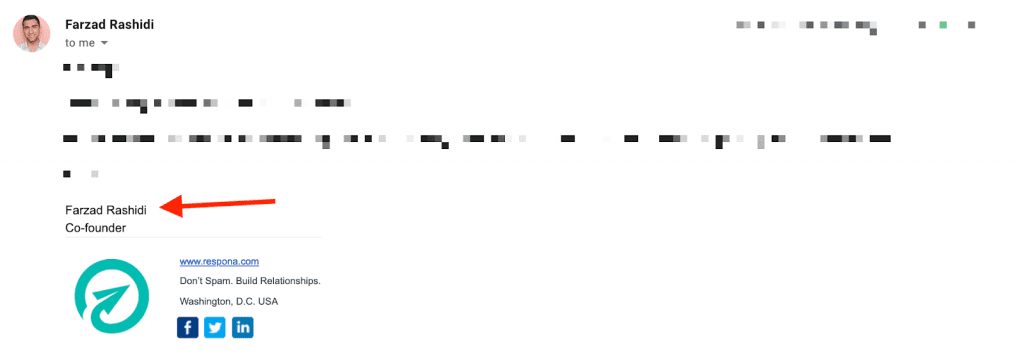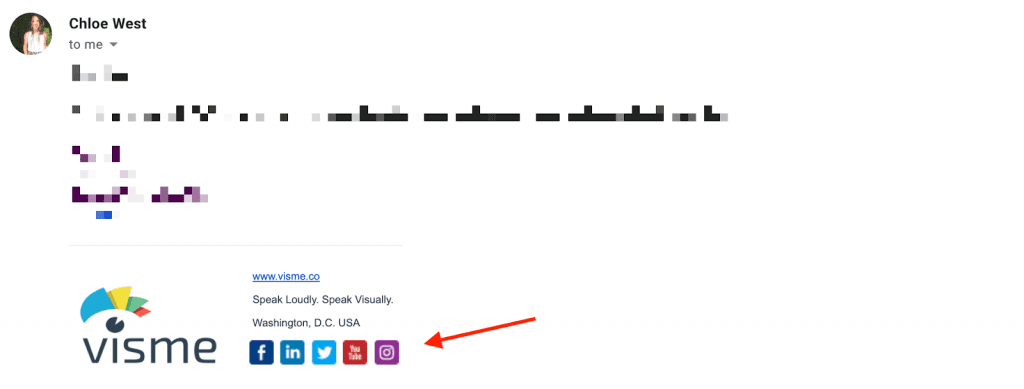Wondering how to end an email politely and in a professional manner?
Read these 43 best ways to sign off an email to find out.
Here is what we’re covering:
- Why is the closing of a professional email important?
- What are some of the best and most common cold email sign-offs?
- Additional tips that will help you make your email signature stand out
Let’s get started.
- Email Closing 101: Why is the Closing of an Email Important?
- What is an Email Closing Line and Do You Need It?
- Formal Email Sign-Offs
- Informal Email Sign-Offs (That Can Be Used In Some Formal Communications)
- Casual Email Sign-Offs
- How NOT to End an Email
- 6 Tips to Help You Create an Email Signature that Stands Out
- Now Over to You
Link building cheat sheet
Email Closing 101: Why is the Closing of an Email Important?
Before we dive into some of the best ways to sign off a professional email, let’s first elaborate on why the closing of an email is important.
Some of you might think that all that matters when cold emailing is the content of the email itself.
In other words, the body of text and the information you’re giving the email recipient is where you’d think the value is.
Although no one would argue that the content of an email is unimportant, we can definitely assert that the way you introduce yourself in an email, as well as the way you sign off, are equally important.
Your sign off salutation and the information you’ll be giving the recipient of your email can make a significant difference in terms of your email getting noticed and getting replied to.
Which is why we all send out emails, right?
Although we’d love to sign off with a “Ciao” more often – ciao sounds really cool! – a professional email closing requires us to be more considerate of how our emails will be perceived.
To cut a long story short, what you should keep in mind when signing off your emails is that certain sign-offs can lead to higher response rates.
What is an Email Closing Line and Do You Need It?
Sign-offs and closing lines are two terms that are often confused.
The professional closing line is the final sentence of your email that comes right before the sign-off.
It is usually used to sum up the email, thank the recipient, or provide a CTA (call-to-action) to provide clear next steps for the reader.
It is a good practice to include a closing line before the sign-off for two reasons:
- It makes you look more professional
- It acts as a failsafe ensuring that your recipient understood what it is that you wanted from them
An example of a closing line along with a sign-off is:
“Thank you for booking a meeting with me at 4PM tomorrow.
Looking forward to chatting with you,
[signature]”
Let’s now go through a list of email closings you should definitely consider using.
Formal Email Sign-Offs
Yours truly
Use cases: Many argue that closing phrases like “Yours truly” – or the variation you see right below this sentence – might sound too formal and stiff, so avoid using them with regular email clients and people you have regular contact with.
Variations: Yours faithfully
Sincerely
Use cases: You might want to use this word and its variations for professional emails, for example when sending a cover letter or proposal.
Variations: Yours sincerely, Sincerely yours
I appreciate your feedback
Use cases: It can be used as an email closing sentence for an email to a colleague that’ll help you with polishing one of your tasks or to your manager who’ll review your work, or a customer support email asking for customer feedback.
Variations: I appreciate your input, I appreciate your opinion, I appreciate your help
Thanks for your consideration
Use cases: When you want to thank a potential client for considering using your services and products and general email marketing messages.
Author’s Tip: Make sure you use this closing line to your advantage by trying to get insight on the prospect’s decision and their future moves in relation to your potential collaboration.
Variations: Thank you for your time
Respectfully
Use cases: When writing a very formal closing for an email to someone with position and influence you’ve never spoken before.
Variations: Respectfully yours, Yours respectfully
Cordially
Use cases: Business correspondence with personal undertones, useful when you’re not too sure how much formality you should go for.
Variations: Warmly
Regards and Thanks
Use cases: This sign-off is perfect when you want to convey both professionalism and gratitude. It’s suitable for client interactions, project updates, and any scenario where acknowledgment is key.
Variations: Thanks and regards, Best regards and thanks
Author’s Note: This compound sign-off helps to reinforce your appreciation while maintaining a formal tone, ideal for various professional settings.
With Deepest Respect
Use cases: Best used when addressing individuals in senior positions, stakeholders, or those you want to show a high level of respect.
Variations: With profound respect, With utmost respect
Author’s Note: This sign-off strikes a balance between formality and genuine respect, making it suitable for hierarchical communications.
In Appreciation of Your Time
Use cases: Suitable for following up on meetings, feedback requests, a sales email or any situation where you want to emphasize your gratitude for the recipient’s time and input.
Variations: Appreciatively yours, With sincere appreciation
Author’s Note: This email ending shows that you value the recipient’s time, helping to build a positive professional rapport.
Awaiting Your Response
Use cases: Ideal for follow-up emails or when waiting for a decision and you want to convey a sense of urgency professionally.
Variations: Awaiting your reply, Looking forward to your prompt response
Author’s Note: Use this sign-off to keep the momentum going in a transactional email subtly indicating that you need timely feedback.
With Professional Regards
Use cases: Suitable for sending reports, official documents, interactive PDFs or formal requests.
Variations: With regards, Professional regards
Author’s Note: This sign-off upholds a high level of formality and is fitting for higher-stakes professional interactions.
Your Attention is Appreciated
Use cases: Best used when you want to thank someone for their attention to a certain matter, such as reading through a proposal or report.
Variations: Appreciative of your attention, Thanks for your attention
Author’s Note: This sign-off effectively acknowledges the recipient’s effort and attention, further encouraging them to engage with your email’s content.
Informal Email Sign-Offs (That Can Be Used In Some Formal Communications)
Thanks
Use cases: “Thanks” can be used as an email sign off when you actually want to thank someone for something they did.
Additionally, it’s a nice and polite way to close an email and makes it more likely that the email recipient will get back to you.
Variations: Thank you, Many thanks, All my thanks, Thanks so much
Best regards
Use cases: It works perfectly as an ending line for formal emails and it’s ideal for initial email communications.
Variations: Warm regards, Kind regards, Regards, Kindest regards
Author’s Tip: In terms of signing professional emails, steer clear from abbreviations like Rgds because your email will most likely sound far too informal.
Best wishes
Use cases: There’s nothing unexpected about the closing phrase “Best wishes” at the end of a business email. It can be used to end pretty much any professional email, business letters, as well as the follow up email.
Variations: Warm wishes
Thanks in advance
Use cases: When you want to thank someone in advance that you’ve just asked them to do in the preceding email.
Variations: Thank you in advance
Author’s Tip: When using phrases like this one, try to sound as undemanding as possible.
Instead, try to actually show that you’re thanking someone who’s about to help you instead of showing that they should be obliged to help you.
Cheers
Use cases: When sending emails to colleagues or external collaborators you have a friendly, developed, and less formal relationship with.
Best
Use cases: This email closing word, as well as its variations, can be used – in most cases – interchangeably in pretty much all email communications as a safe bet when you can’t decide what else works.
Variations: All best, All my best, All the best
Hope to hear from you
Use cases: When writing an email to a prospective client or collaborator that you’re keen to get a reply from.
Variations: Hope to see your reply soon, Hope to connect soon
Looking forward to hearing from you
Use cases: When writing an outreach email to a potential client or someone you’d like to collaborate with.
Variations: Looking forward to your response, Looking forward to hearing your thoughts
Thanks for your help
Use cases: When writing to a colleague that’s helped you out with something that might not be in your area of expertise.
Variations: Thank you for taking the time to help me/us, I appreciate you taking the time to help
Talk soon
Use cases: When sending an email to a colleague or vendor you have a casual professional relationship with and are in regular contact.
Variations: Speak soon, Chat soon
Have a great week
Use cases: When sending emails to your colleagues, especially on the first days of the week.
Variations: Have a great weekend, Enjoy your week, Enjoy your weekend
Have a nice evening
Use cases: You can use this sign-off to end an email with a colleague or external collaborator. It adds a personal touch and is great when they’ve shared with you that they have plans that night.
Variations: Have a great evening, Enjoy your evening, Hope your evening goes well
Looking forward to seeing you there
Use cases: When inviting a regular client or close colleague to a company event or meeting.
Variations: See you soon, See you there, Catch you then
With appreciation
Use cases: When you want to express your appreciation to someone senior who’s gone out of their way for you.
Variations: Much appreciated
With gratitude
Use cases: When you want to show gratitude to someone for something they did for you.
It might be used between two business associates that don’t know each other well, for example.
Variations: Grateful for your time/help/advice
Do not hesitate to contact me (if you have any questions or concerns)
Use cases: You can consider using this one when communicating with your employees or vendors to show that you’ll be available to help them in case they have questions about a task you’ve assigned them.
Variations: Don’t hesitate to ask any questions, Here to answer any questions
I truly appreciate your gesture
Use cases: This sign-off is ideal for expressing appreciation to someone who did a nice and thoughtful thing for you, like sending a gift or making a referral.
Variations: I truly appreciate your words, I truly appreciate your feedback, I truly appreciate you thinking of me
Keep up the good work!
Use cases: This ending line can be successfully used from an employer to an employee that’s giving their best self at work.
Variations: You’ve done great with this! Great work, keep it up!
Casual Email Sign-Offs
Take care
Use cases: It’s a great, casual closing line for a friend or familiar colleague.
However, it should be avoided for business emails because it can be considered too intimate.
Variations: Be safe
Have a good one
Use cases: When sending a friendly email to your work partner, particularly when you know they have a challenge or task to work on.
Variations: Have a good day ahead, Enjoy your day
xoxo
Use cases: Only between close friends, family members, and loved ones. Too informal for anything else!
Variations: xxx, ;)
Stay Awesome
Use cases: “Stay awesome” is a friendly and upbeat sign-off suitable for colleagues, teammates, and any professional contacts with whom you have a more casual relationship.
Variations: Stay fantastic, Stay amazing
Author’s Note: Use this sign-off in contexts where energy and morale are high, and you want to end the email on a positive, uplifting note.
Stay Safe
Use cases: Particularly relevant in times of widespread health concerns or during hazardous weather conditions, this sign-off shows care and regard for the recipient’s well-being.
Variations: Keep safe, Be safe out there
Author’s Note: A thoughtful sign-off that acknowledges current events or circumstances, making your email feel timely and considerate.
Warm Regards
Use cases: Excellent for everyday formal correspondence, this sign-off provides a warm touch while keeping the closing remark respectful.
Variations: Warmest regards, Best warm regards
Author’s Note: Use this when you want to convey friendliness without compromising professionalism, ideal for frequently contacted clients or colleagues.
Much Appreciated
Use cases: Suitable when you wish to convey gratitude for a favor or assistance received from a colleague or business associate.
Variations: Greatly appreciated, Deeply appreciated
Author’s Note: This sign-off shows genuine appreciation while maintaining a level of professionalism, making it versatile for various contexts.
Catch You Later
Use cases: Ideal for emails with close colleagues or friends within the workplace, especially when arranging casual meetups or informal discussions.
Variations: Catch ya later, See you soon
Author’s Note: This sign-off is great for maintaining a relaxed and approachable tone, suitable for teams with a laid-back culture.
Keep Shining
Use cases: Perfect for emails to colleagues or team members who consistently perform well or need a boost of encouragement.
Variations: Keep sparkling, Shine on
Author’s Note: This positive and motivational sign-off is excellent for fostering a supportive and encouraging work environment.
To Great Days Ahead
Use cases: Appropriate for concluding emails that contain good news or plans for future developments.
Variations: Here’s to great days, To good times ahead
Author’s Note: This sign-off projects optimism and a forward-thinking attitude, making it ideal for celebratory or anticipatory emails.
Laters
Use cases: Suitable for quick, informal exchanges with close coworkers or friends in the workplace.
Variations: Chat laters, Speak laters
Author’s Note: Use this when the tone is extremely relaxed and you have a well-established rapport with the recipient.
See Ya
Use cases: Best for internal communications within a casual team or startup where informal language is the norm.
Variations: Talk to ya, See ya soon
Author’s Note: This ultra-casual sign-off should only be used in environments where formality is unnecessary and informality is appreciated.
Looking Forward to Collaborating
Use cases: Appropriate for emails that initiate or reinforce a new professional relationship, such as partnerships or joint projects.
Variations: Excited to collaborate, Eager to work with you
Author’s Note: Use this to set a positive tone for future collaborations, signaling enthusiasm and readiness.
Take Care
Use cases: Useful for semi professional communication where you want to convey a friendly, caring tone without being too casual.
Variations: Take care of yourself, Take good care
Author’s Note: This sign-off strikes a balance between professional and personal, making it suitable for regular contacts with whom you share a warm rapport.
How NOT to End an Email
Later
Use cases: “Later” might be tempting to use when you’re in a hurry or conversing with a close friend, but it lacks the formality and warmth needed in professional or new correspondences.
Why to Avoid: Email endings with “Later” can inadvertently convey a sense of indifference or a lack of professionalism. It may leave the recipient with an impression that their conversation or the business communication is not being taken seriously.
Author’s Tip: Reserve “Later” for casual, informal interactions with people with whom you have an established rapport. When in doubt, opt for a more traditional closing that maintains a tone of respect and reflects the professionalism of the exchange.
Peace
Use cases: It might be appropriate among friends in a personal email but can undermine the tone in business correspondence or with those you don’t know well.
Why to Avoid: “Peace” carries cultural and informal connotations that may not match the professionalism expected in business communications, potentially leading recipients to view the sender as unprofessional or too casual.
Author’s Tip: It’s best to match the formality of your sign-off with the context of your email. When you’re aiming for a professional tone, opt for more universally accepted closings like “Best regards” or “Sincerely.” Save “Peace” for personal exchanges where unprofessional closings are established and welcomed.
Yours
Use cases: “Yours” may seem appropriate when you’re aiming for an affectionate tone, but it lacks the necessary clarity and formality for most professional situations.
Why to Avoid: A standalone “Yours” might be misconstrued due to its brevity and potential personal undertones, which can be off-putting in a business setting or when the relationship doesn’t warrant such familiarity.
Author’s Tip: When leaning towards a personal but still professional sign-off, consider extending “Yours” to “Yours sincerely” or “Yours truly” to give it a more complete feel. These extended forms strike a balance between warmth and professionalism, being better suited for various email contexts.
Sent from my [Device]
Use cases: While this preset signature is common for quick replies sent from mobile phones or tablets, it should not replace a personalized sign-off in business emails or formal communications.
Why to Avoid: “Sent from my [Device]” comes across as impersonal and can create the impression that the sender has not made the effort to craft a proper closing. It also places unnecessary focus on the device used rather than the message content.
Author’s Tip: Take the time to personalize your email sign-off, especially in a professional setting. It doesn’t have to be elaborate; something as simple as “Best regards” or “Thank you” demonstrates your intention to conclude the email thoughtfully. Remember to disable or customize your device’s default email signature to something more fitting for the context of your messages.
Love
Use cases: “Love” is a powerful sign-off best reserved for close family members and friends. It’s not suitable for workplace communication or when engaging with clients and colleagues.
Why to Avoid: Using “Love” can blur the boundaries of professional decorum and may cause discomfort or misinterpretation among recipients who maintain a formal relationship with the sender.
Author’s Tip: Keep the professional context in mind and choose sign-offs that respect the nature of your relationship with the email recipient. Consider alternatives such as “Best wishes” or “Kind regards” to maintain warmth without overstepping professional boundaries. Reserve “Love” for personal conversations where the emotional connection is explicit and mutual.
TTYL
Use cases: “TTYL” might fit in casual texts or messages among friends but isn’t suited for business emails, formal requests, or correspondence with individuals you do not have an informal relationship with.
Why to Avoid: “TTYL” can come across as overly casual or dismissive in a professional setting. It fails to convey a sense of professionalism and may reduce the seriousness of your message.
Author’s Tip: Opt for more professional alternatives that convey a readiness for ongoing communication, such as “Looking forward to your response” or simply “Best regards.” These sign-offs maintain the intended professional tone and show respect for the recipient’s role in the conversation. Reserve “TTYL” for personal and informal exchanges where the context justifies a relaxed tone.
Ciao
Use cases: “Ciao” might be suitable for friends or colleagues in creative industries where the communication style leans towards the informal. However, it’s not recommended when addressing superiors, potential clients, or anyone in formal business circumstances.
Why to Avoid: In the context of professional emails, “Ciao” may come off as too laid-back, potentially undermining the seriousness of your message or your commitment to professional decorum.
Author’s Tip: Assess the nature of your relationship with the email’s recipient and the cultural context. Opt for more conservative closings like “Kind regards” or “Sincerely” to maintain professional credibility. Save “Ciao” for those with whom you’ve established an informal rapport or for personal correspondence, where its friendly tone is more appropriate.
[No sign-off]
Use cases: While you might be in a rush or feel that a sign-off isn’t necessary for quick replies or informal chats, it is almost always expected in professional or external business communications.
Why to Avoid: Skipping a sign-off in professional emails might give the impression of being inattentive or even rude. It can leave the conversation feeling unfinished, which isn’t ideal when you’re looking to maintain or establish a good rapport.
Author’s Tip: Always take a moment to end your emails with a proper sign-off. It doesn’t have to be elaborate—something as simple as “Best regards” or “Thanks” will suffice. It shows the recipient you’ve put thought into your correspondence from start to finish. Avoid leaving the ending of your emails to chance, and ensure you always sign off with intention and professionalism.
6 Tips to Help You Create an Email Signature that Stands Out
An email signature is like a standardized email template that people use to sign off their emails.
Email signatures are mostly used in professional email communications and usually include essential contact information.
There is no single “right way” to build a signature, but let’s break down some important tips that’ll help you create an effective email signature that stands out.
Tip #1: Make sure to include your full name
The first tip we have for you in terms of your email signature is to include your full name.
Your full name should go right under the body of your email.
Have a look:

Including your full name is a must for the first time you’re communicating with someone.
Although it’s not necessary to sign off with your full name when you’re having regular email communication with someone, or when exchanging emails with a close friend, your full name must be part of your professional email signature.
Here’s our second tip.
Tip #2: Make sure to include your contact information
The second tip we have for you is to make sure to include your contact information.
A default email signature includes all necessary contact and personal information that’ll give the recipient alternative communication routes in case they’d prefer to get back to you in ways other than email.
This is helpful because people might prefer having phone calls or sending letters.
For that reason, you should consider including information like your phone number, fax number, alternate email address, business website and your work address if it’s a professional correspondence.
Let’s now move on to the third tip.
Tip #3: Provide links to your social media accounts
The third tip we have for you is to include your social media account links in your email signature.
Similar to what we’ve already discussed about including contact information that’ll help the email recipient contact you in alternative ways, your social media accounts might do exactly that.
People love to stay connected on social media with people they have personal or a professional relationship with, so make sure you include some of your social media account information.
It can be your Linkedin and Twitter profiles for professional email correspondence.
Here’s how your email signature with links to your social media accounts might look like:

As simple as that.
Moving on to the next tip.
Tip #4: Provide the email recipient with your job title
Alongside your social media profiles and other contact information, it’d be great to provide the email recipient with your job title.
Exactly like shown in the snapshot below:

Again, this tip mostly applies to first time professional emails.
Knowing your job title or job position within a company is very helpful for someone receiving your email.
Additionally, it might play a significant role in terms of the response rate of your emails.
In other words, your job title might make it more likely that the recipient will send you back a more appropriate response.
Have a look at the second to last tip in terms of creating your email signature.
Tip #5: Stay away from ‘Sent from my iPhone’ types of sign offs
A rather important tip we want to share with you is to avoid using email sign offs that indicate the type of device you used to send your emails from.
This basically means that you need to dedicate some time to deactivating automated sign offs that might come with your device or certain apps, that’ll show the recipient the type of device you used to write and send your email.
Although some say that a ‘sent from my iPhone’ line helps them justify potential typos, we stick to our conviction that such lines are unnecessary pieces of information no one really needs to know about.
Keep reading to check out our last email signature tip.
Tip #6: Keep your email signature short and simple
The last tip we have for you when tailoring your email signature is to keep it short and simple.
You can use a company logo or a graphic if you want to, but your email signature should overall be short and as minimal as possible.
The most important thing to remember is to include the pieces of information the recipient needs to know about you and that should be enough.
Let’s wrap this post up with a few final comments and a question for you.
Link building cheat sheet
Now Over to You
There you have it.
You now know everything about ending an email in a professional manner, so that you can always make a positive impression.
If you need help streamlining your email outreach campaigns, don’t hesitate to start your 14-day free trial with Respona to see how we can help!







